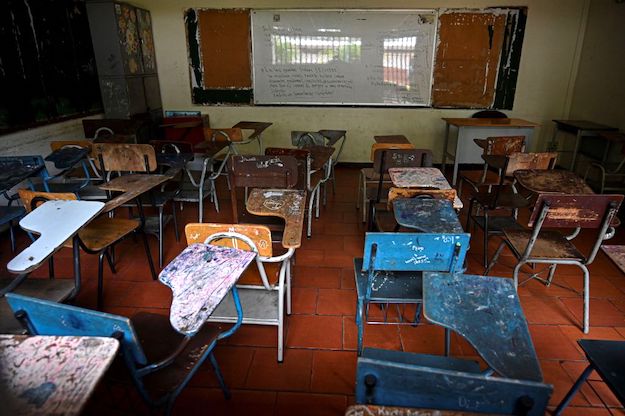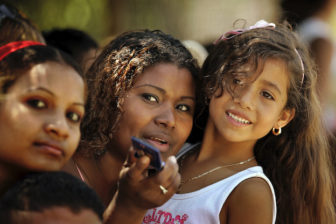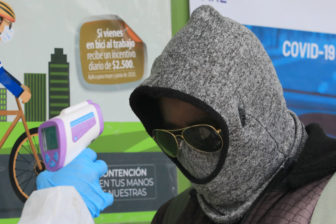MEXICO CITY – Before her classes moved online in March, Emilia Álvarez, a high school math teacher in Bogotá, Colombia, was given a three-hour crash course in distance learning. Unfortunately, what to do about students who could only connect through WhatsApp or a pay-as-you-go data plan wasn’t yet on the curriculum.
“We’ve found that many of our students don’t have the tools they need to participate in virtual education,” Álvarez told AQ. “Some don’t have internet access at all.”
Since the outbreak began, education officials across Latin America have rushed to get virtual education plans up and running. But the region is starting from behind, lacking much of the internet infrastructure, teacher training and familiarity with classroom technologies needed to ensure students can keep learning under lockdown.
Millions of Latin American students don’t have access to the internet. Less than 30% of low-income families in the region have a home computer for schoolwork, and only around 60% of secondary school teachers have the skills needed to use digital technologies in their lessons, according to PISA data, let alone teach entirely online.
In a recent web panel on home-based learning in Latin America, Fernando Reimers, a professor of education at Harvard University, estimated that online classes would be a success for, at best, around 20% of students.
To compensate, teachers, administrators, parents and students are finding creative ways to adapt. Álvarez’s school works with mom-and-pop office supply stores near students’ homes to deliver printed course materials. Other students’ families, teachers and administrators have chipped in to help those in financial need.
“Despite all of the difficulties that families are going through, there’s been a real show of solidarity in the education community to try to help,” Álvarez said.
But many students in the region are venturing to cyber-cafés or paying for short-term internet plans to access online course materials – an additional cost for families whose incomes have been hit hard by the pandemic, and a health risk for students who have to leave the house in order to learn. Álvarez said she’s seen a drop in performance for those students who don’t have access, or who have to share a single family computer or cell phone with their siblings.
“We could be talking about learning differences of a full school year between high- and low-income students in three months,” Mercedes Mateo Díaz, an education specialist at the Inter-American Development Bank, told AQ, citing evidence from studies on learning losses during summer breaks.
There is some hope that the coronavirus could offer the region an opportunity to build the educational infrastructure it lacks, forcing governments and school administrators to innovate. But the challenges are immense.
Spending on education as a percentage of GDP in the region is not far off that of developed economies, but learning outcomes lag. Chile, Latin America’s leader in math, science and reading PISA scores, trails the OECD average in each category by 17%, 10% and 8%, respectively, according to 2018 figures.
“We’ve been complacent with the ways schools evolved”
Emiliana Vegas, education specialist at the Brookings Institution
Inequality is also prevalent within Latin America’s school systems. While nine out of 10 children from the richest 20% of the population attended pre-primary school in 2017, the figure was just five out of 10 for the poorest 20%, according to the World Bank. Most students at all income levels attend at least some classes at intermediate grades, but the gap between rich and poor widens again in high school and, especially, university.
Several countries were already trying to make up ground by investing in expanded internet access and connectivity for students. Some, such as Uruguay, where 98% of students have access to a computer, are further ahead than others. But for many, the coronavirus risks exacerbating the deep inequalities that already exist in their education systems.
“Could (educational losses) be avoided? Yes, Uruguay is a good example. But it requires a vision, strong will and determination, and state policies accompanied by steady investments that go beyond a particular government,” Mateo said.
In the short term, school systems across the region have turned to community radio and TV programming to offset unreliable internet connections. In Mexico, “Aprende en Casa TV” airs basic education programming for kindergarten and elementary school students by grade throughout the day.
With e-learning expected to be a $3 billion industry in Latin America by 2023, public-private partnerships are also helping to patch up lesson plans. In Colombia, a government platform directs students and teachers to e-learning apps, online courses and educational games provided by third-parties, as well as its own home-learning kits and radio and TV programming.
But a more complete solution will take years of investment, experts say.
“It’s emergency education,” Emiliana Vegas, co-director of the Center for Universal Education at the Brookings Institution, told AQ of efforts to continue classes online. “It’s trying to provide at least some educational opportunity, but it’s nowhere near what kids were receiving in schools.”
That means school systems in the region will have to find creative ways to return to the physical classroom, even as they invest more in digital technologies and training.
To speed things up, administrators could take advantage of empty hotels and public buildings or parks, converting them into makeshift classrooms that would allow for more socially distanced learning, Vegas suggested. Classes in Álvarez’s school averaged around 45 students each, making a quick return to the pre-outbreak setup next to impossible.
Educators will also need to adapt future learning plans based on students’ individual experience during the outbreak, and consider broader changes to schooling that would allow students more control over when and how quickly they learn new material.
“We’ve been complacent with the ways schools evolved,” Vegas said. “Do we really want all kids to be learning the same thing, at the same pace, at the same time?”









